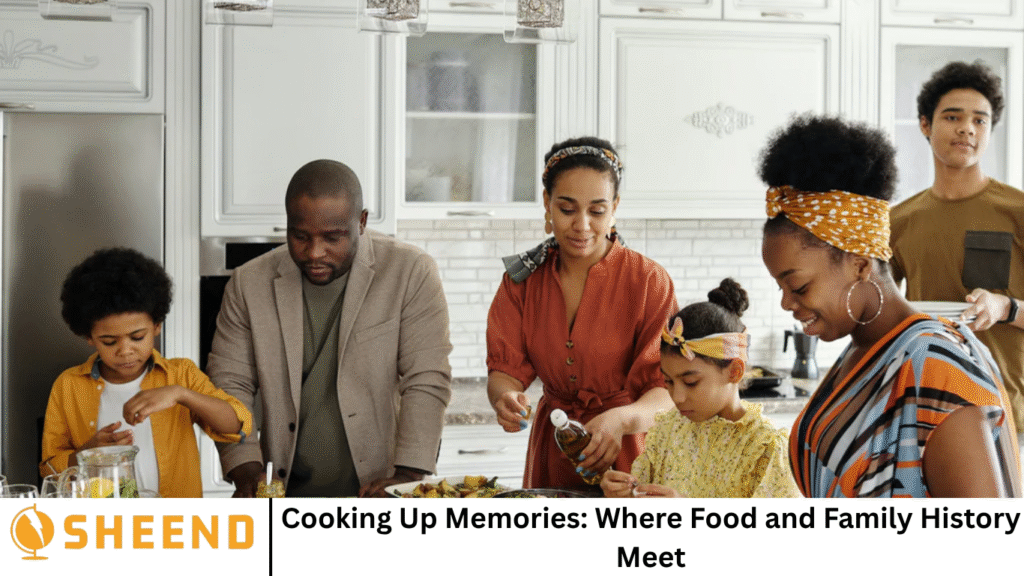The scent of freshly baked bread. The sizzle of onions in a hot pan. The clatter of cutlery and laughter around a dinner table. These aren’t just sensory moments—they’re stories, family traditions, and connections passed down through generations. Food has always been more than sustenance; it’s a symbol of love, culture, and legacy.
Cooking up memories means more than recreating old dishes. It’s about reviving traditions, celebrating roots, and building connections. From immigrant recipes adapted to new countries to favorite comfort meals passed down to grandchildren, the kitchen becomes a living museum of family culture.
In this article, we’ll explore how food serves as a powerful vessel for preserving family history, how to document culinary traditions, and how cooking together strengthens bonds. Whether you’re a home cook or a family historian, these stories and tips will inspire you to stir the past into the present.
More Read: Mastering the Art of Oral History Interviews
The Emotional Power of Food
Food often triggers powerful memories. A single taste can transport someone back to a childhood kitchen or a loved one’s warm embrace. Scientists refer to this as “Proustian memory,” a phenomenon where taste and smell evoke vivid recollections. This emotional connection makes food one of the most effective—and meaningful—tools for storytelling.
For many families, food is love in edible form. Whether it’s a father’s signature barbecue rub or a grandmother’s holiday cookies, each dish contains layers of meaning. These meals form the backdrop of holidays, milestones, and even simple weeknight dinners—moments that become treasured memories over time.
The Kitchen as a Storytelling Space
In many cultures, the kitchen is more than a place to prepare meals. It’s the heart of the home—a gathering place where stories unfold naturally. While peeling potatoes or stirring sauces, generations talk, laugh, and share wisdom. Recipes are handed down not just through instructions, but through shared experience.
Children often learn to cook by watching, helping, and tasting—not just by reading cookbooks. Through these moments, cultural values, family jokes, and life lessons are passed on. A grandmother’s kitchen, for instance, might be where a child learns the art of patience, the importance of hospitality, or the history of their people.
Recipes as Heirlooms
Many families treasure handwritten recipes like sacred texts. A splattered index card or worn cookbook page is more than a cooking guide—it’s a keepsake infused with nostalgia. These documents connect us to ancestors and preserve their legacy in a tangible, delicious form.
Documenting recipes is a beautiful way to honor your heritage. Some ideas include:
- Creating a family recipe book: Gather recipes from different family members, include photos and anecdotes.
- Digitizing handwritten notes: Scan and preserve recipe cards before they fade.
- Filming cooking sessions: Record elders as they prepare dishes to capture their techniques and stories.
Passing down recipes is one way to keep a family’s story alive. And each time the dish is made, that legacy continues to feed the present and the future.
Cultural Heritage on a Plate
Food also serves as a direct link to cultural identity. Immigrant families, in particular, use traditional meals to stay connected to their homeland. Even when language barriers exist or cultural practices fade, recipes remain a resilient bridge to one’s roots.
For example:
- Italian families may carry on traditions of Sunday pasta dinners.
- Mexican households might pass down generations-old tamale recipes.
- Jewish families often maintain customs through matzo ball soup or challah baking.
These culinary customs serve both as comfort and resistance to cultural erasure. Teaching the next generation how to prepare these dishes is an act of preservation and pride.
Recreating Lost Recipes
What if your family doesn’t have written recipes? Don’t worry—it’s still possible to piece together your culinary heritage. Here are a few tips:
- Interview relatives: Ask elders what they remember about family meals. Record their stories.
- Visit local or cultural archives: Some communities preserve regional or immigrant culinary traditions.
- Experiment in the kitchen: Use your senses to recreate flavors from memory.
- Connect through community groups: Food heritage groups on social media can offer support and shared experiences.
Even if a recipe isn’t perfectly reconstructed, the act of trying to revive it can be meaningful in itself.
Cooking Together Builds Stronger Bonds
Cooking is a collaborative process that brings people together. Families that cook and eat together often report stronger relationships and improved communication. These shared moments allow space for:
- Teamwork and creativity
- Problem-solving across generations
- Storytelling and memory-sharing
Cooking with kids, for example, teaches them not only practical skills but also instills values of tradition, patience, and gratitude. Including children in holiday baking or weeknight prep connects them to a larger family narrative.
Similarly, cooking with older family members provides opportunities to hear untold stories and capture memories that might otherwise fade.
Starting Your Own Family Food Tradition
Even if your family doesn’t have long-established culinary traditions, it’s never too late to start. Building your own food rituals can be a beautiful way to create memories and establish legacy. Consider:
- Weekly themed dinners (e.g., Taco Tuesdays or Pasta Fridays)
- Holiday recipe experiments
- Family cook-offs or recipe challenges
- Documenting dishes in a shared family blog or binder
Over time, these traditions will become the stories your children and grandchildren share—and the meals they’ll cook with love.
Frequently Asked Question
Why is food such a powerful trigger for memories?
Food activates multiple senses—taste, smell, touch, and sight—making it strongly linked to the brain’s memory centers. Even a single bite or aroma can evoke vivid emotional recall, often tied to meaningful people, places, or events.
How can I preserve my family’s recipes for future generations?
Start by collecting handwritten recipes, recording cooking sessions, or compiling a digital recipe book. Include photos, family stories, and even voice notes to enrich the history behind each dish.
What if my family never documented their recipes?
That’s common. Interview relatives, experiment with recreating dishes based on memory, and don’t worry about perfection. The journey itself—trying, sharing, remembering—is what truly matters.
How can I involve children in preserving food traditions?
Let them help in the kitchen, explain the stories behind certain meals, and give them age-appropriate tasks. Include them in planning menus or ask them to interview older relatives for a family cookbook project.
Are there apps or tools to help document family recipes and stories?
Yes! Apps like StoryWorth, Cookpad, and FamilySearch Memories can help you organize stories, scan handwritten notes, and store family recipes in a collaborative space.
What role does food play in cultural preservation?
Food is one of the most enduring aspects of culture. It keeps traditions alive, helps immigrant families stay connected to their homeland, and allows communities to celebrate and pass down identity.
How do I start a new food tradition in my family?
Begin with something simple and repeatable. Try a monthly dish everyone looks forward to or a cooking night where each person contributes. Over time, it will evolve into a cherished tradition.
Conclusion
The kitchen isn’t just where meals are made—it’s where memories simmer, heritage is served, and love is tasted. Whether you’re reviving old recipes, inventing new ones, or simply cooking together, every dish becomes a chapter in your family’s story. In a world that’s constantly rushing forward, food offers a beautiful way to pause, reflect, and connect. So next time you prepare a beloved dish or try something new, remember: you’re not just feeding the body—you’re nourishing the soul and preserving a legacy. Cooking up memories is a delicious journey worth sharing.


